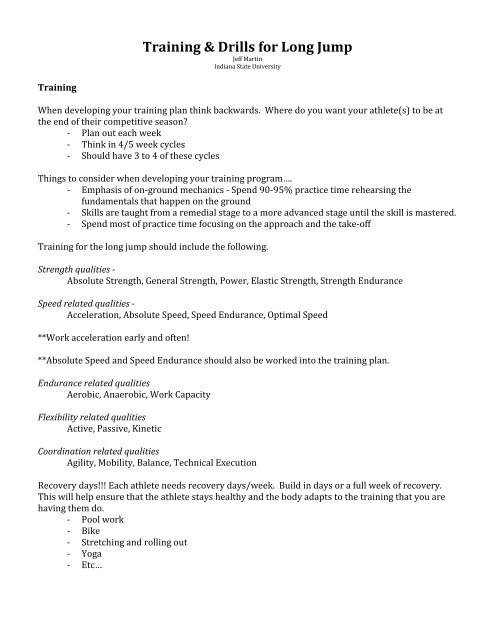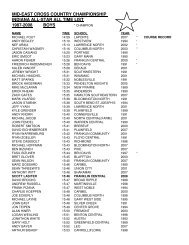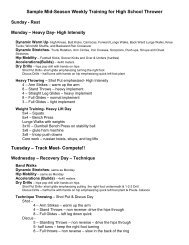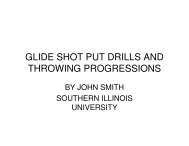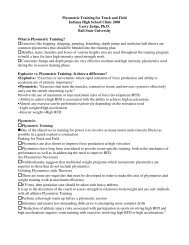Long Jump Training and Drills - iatccc
Long Jump Training and Drills - iatccc
Long Jump Training and Drills - iatccc
Create successful ePaper yourself
Turn your PDF publications into a flip-book with our unique Google optimized e-Paper software.
<strong>Training</strong> & <strong>Drills</strong> for <strong>Long</strong> <strong>Jump</strong><br />
Jeff Martin<br />
Indiana State University<br />
<strong>Training</strong><br />
When developing your training plan think backwards. Where do you want your athlete(s) to be at<br />
the end of their competitive season?<br />
- Plan out each week<br />
- Think in 4/5 week cycles<br />
- Should have 3 to 4 of these cycles<br />
Things to consider when developing your training program….<br />
- Emphasis of on-ground mechanics - Spend 90-95% practice time rehearsing the<br />
fundamentals that happen on the ground<br />
- Skills are taught from a remedial stage to a more advanced stage until the skill is mastered.<br />
- Spend most of practice time focusing on the approach <strong>and</strong> the take-off<br />
<strong>Training</strong> for the long jump should include the following.<br />
Strength qualities -<br />
Absolute Strength, General Strength, Power, Elastic Strength, Strength Endurance<br />
Speed related qualities -<br />
Acceleration, Absolute Speed, Speed Endurance, Optimal Speed<br />
**Work acceleration early <strong>and</strong> often!<br />
**Absolute Speed <strong>and</strong> Speed Endurance should also be worked into the training plan.<br />
Endurance related qualities<br />
Aerobic, Anaerobic, Work Capacity<br />
Flexibility related qualities<br />
Active, Passive, Kinetic<br />
Coordination related qualities<br />
Agility, Mobility, Balance, Technical Execution<br />
Recovery days!!! Each athlete needs recovery days/week. Build in days or a full week of recovery.<br />
This will help ensure that the athlete stays healthy <strong>and</strong> the body adapts to the training that you are<br />
having them do.<br />
- Pool work<br />
- Bike<br />
- Stretching <strong>and</strong> rolling out<br />
- Yoga<br />
- Etc…
Testing – Testing is a good way to see if your training is doing what you want it to do. Also giving the<br />
athlete a chance to see improvement. Do this 2-3 times a year. Good way for you to make<br />
adjustments in your training plan. Keep records for each of your athletes.<br />
- Over head shot put<br />
- Underh<strong>and</strong> shot put<br />
- St<strong>and</strong>ing 30m<br />
- Flying 30m (10m run in)<br />
- St<strong>and</strong>ing LJ<br />
- St<strong>and</strong>ing three double leg jumps<br />
<strong>Drills</strong><br />
Be sure that each drill has a purpose. Don’t just do drills to do drills. Athletes must learn to master<br />
the basic drills of the take off!!<br />
When training for the long jump make sure that you as the coach work on training each side of the<br />
body. Being over-developed on one side can lead to problems in the jumps.<br />
Be sure you are working on good posture the entire year!! Good posture leads to good jumps. Bad<br />
posture can lead to bad jumps.<br />
Approach runs are a must. Work up to developing meet approach length.<br />
- Start off the runway first<br />
- Move to runway<br />
- Approach runs with a pop up<br />
- NO FULL JUMPS IN PRACTICE<br />
Master basic skills early <strong>and</strong> continue to work on them throughout the entire year.<br />
- Prep for take-off<br />
- Take-off<br />
- L<strong>and</strong>ing<br />
Short approach jumps vs. Full approach jumps.<br />
- Less stress on the body<br />
- More jumps<br />
- Due to slow nature of the short approach jump this makes the athlete have to do things<br />
correctly.<br />
- Off the board<br />
- Off a box<br />
- Off an incline box<br />
- Off a spring board<br />
Plyometric Exercise are a good tool for any jumper. When incorporating these exercises be sure to<br />
consider the athlete’s ability, age, <strong>and</strong> training age. Contacts per training session will be different for<br />
each athlete. Error on the safe side <strong>and</strong> do less contacts if need be. These exercises can include.<br />
- Short bounds – double or single leg<br />
- In place jumps<br />
- Extended bounds<br />
- Depth <strong>Jump</strong>s
Approach <strong>Drills</strong><br />
*Wall Drill (walking)<br />
*Wall Drill (jogging)<br />
*Roll over Starts (15m-20m)<br />
*Full Approach runs on the track (NO BOARD) no jump<br />
*Full Approach runs on the runway no jump<br />
*Full Approach runs on the runway with small pop up<br />
Takeoff <strong>Drills</strong><br />
*Skip for height (Heal to Toe action)<br />
*Skip for distance (Heal to Toe action)<br />
*Continuous fast leg paw back with take-off foot (15m)<br />
*5/6 foot take-off drill (Heal to Toe action)<br />
*Run, Run, <strong>Jump</strong><br />
*Run, Run, <strong>Jump</strong> (takeoff foot)<br />
*Run, Run, <strong>Jump</strong> (penultimate foot)<br />
*Run, Run, <strong>Jump</strong> (lowering of the body)<br />
*Run, Run, <strong>Jump</strong> (w/arms)<br />
*Continuous takeoffs over 5 hurdles<br />
*One step roll over take-off foot into s<strong>and</strong><br />
*Three step roll over take-off foot into s<strong>and</strong> w/l<strong>and</strong>ing<br />
*Five step roll over take-off foot into s<strong>and</strong> w/l<strong>and</strong>ing<br />
*Short approach jumps (3-5 steps)<br />
*Short approach jumps w/box (3-5 steps)<br />
*Short approach jumps w/penultimate step on box<br />
*St<strong>and</strong>ing <strong>Long</strong> <strong>Jump</strong> (gymnastic l<strong>and</strong>ing)<br />
*St<strong>and</strong>ing <strong>Long</strong> <strong>Jump</strong> (Squat)<br />
*St<strong>and</strong>ing <strong>Long</strong> <strong>Jump</strong> (Kick out)<br />
*St<strong>and</strong>ing <strong>Long</strong> <strong>Jump</strong> (L<strong>and</strong>ing)<br />
*2 step l<strong>and</strong>ing<br />
L<strong>and</strong>ing <strong>Drills</strong>
Plyo <strong>Drills</strong><br />
1. SIDEWAYS BOX DRILL – to be done over 30/60 or 90 seconds. It is very explosive <strong>and</strong> the jumper must ensure that the contact time<br />
on the floor is minimal <strong>and</strong> that maximum height is attained on each drive from the floor.<br />
2. ALTERNATING PUSH OFF - The jumper places his foot flat on top of the platform. The jumper then drives vertically upwards <strong>and</strong><br />
must attempt to go as 'high as possible' to l<strong>and</strong> on top of the platform. The jumper then re-sets <strong>and</strong> repeats the drill on the other leg.<br />
You could do 5 sets of 5 per leg.<br />
3. HURDLE HOPS - Set out a number of hurdles [the height dependent on age <strong>and</strong> experience of jumper]. The jumper drives two-footed<br />
over the hurdles attempting to go for maximal height <strong>and</strong> limiting flexion at the knee on l<strong>and</strong>ing <strong>and</strong> DRIVING back up immediately<br />
on l<strong>and</strong>ing. Always maintain an upright upper torso. You could do 6 sets over 6 hurdles with 1 minutes recovery between each<br />
repetition.<br />
4. DROP DOWN REBOUND - The jumper 'steps' down - not out from a platform 60-90cms high, <strong>and</strong> on l<strong>and</strong>ing on a full foot DRIVES<br />
immediately upwards. There should be no forward lean on l<strong>and</strong>ing. The energy stored in the muscles as they lengthen MUST be used<br />
immediately<br />
5. DROP DOWN REBOUND TO SECOND BOX - The jumper ‘steps down’ <strong>and</strong> on l<strong>and</strong>ing on a full foot DRIVES immediately upwards<br />
VERTICALLY from the floor <strong>and</strong> l<strong>and</strong>s on the top of a second platform. You could extend the drill by using several platforms of<br />
varying heights. You might want to go from a lower platform to a series of higher platforms.<br />
6. DROP DOWN REBOUND TO ATTEMPT TO TOUCH OBJECT– The jumper will attempt to touch an object which is positioned high.<br />
In this example the jumper is rebounding quickly in an attempt to touch the rim of a basketball net.<br />
7. DROP DOWN REBOUND with a dynamic 'vertical impulse' over a hurdle – The jumper ‘steps down’ <strong>and</strong> on l<strong>and</strong>ing on a full foot<br />
drives vertically over a hurdle. The hurdle height is determined by age <strong>and</strong> experience. Remember, the jumper has to REACT<br />
QUICKLY on touchdown <strong>and</strong> drive up <strong>and</strong> use the stored elastic energy IMMEDIATELY. Ensure that the l<strong>and</strong>ing after the hurdle<br />
clearance is firm <strong>and</strong> balanced. There should be no excessive drop of the hips.<br />
A progression would be to place several hurdles in front of the platform.<br />
8. DROP DOWN REBOUND followed IMMEDIATELY with a St<strong>and</strong>ing <strong>Long</strong> <strong>Jump</strong> for distance - The main aim is to react<br />
immediately on touchdown <strong>and</strong> to DRIVE horizontally upwards <strong>and</strong> forwards. I tend to measure some of the repetitions from the toe<br />
to heel.<br />
9. Double footed bounding over a designated distance OR a set number of repetitions - The jumpers must limit the flexion behind<br />
the knee, keep upright <strong>and</strong> react IMMEDIATELY on l<strong>and</strong>ing on a full-foot <strong>and</strong> initiate a dynamic vertical impulse attempting the<br />
extend <strong>and</strong> straighten both legs on the 'upward journey'. I'm looking for height as opposed to distance.<br />
10. <strong>Jump</strong> up to platform - The platform is 90cms high <strong>and</strong> the jumper is lowering his hips slightly then EXPLODING upwards quickly to<br />
l<strong>and</strong> on top of the platform. Start at 60cms <strong>and</strong> build up to 90cms+ gradually. There should be no excessive drop of the hips to initiate<br />
the vertical impulse.<br />
11. St<strong>and</strong>ing <strong>Long</strong> <strong>Jump</strong> to vertical DRIVE upwards on to a platform [height depends on age <strong>and</strong> experience] - The jumper performs<br />
a st<strong>and</strong>ing long jump to a raised platform. IMMEDIATELY on l<strong>and</strong>ing the jumper changes his direction from the horizontal to the<br />
vertical. The jumper MUST try to go as high as possible <strong>and</strong> extend <strong>and</strong> lengthen the legs in the vertical impulse. You will note that<br />
the second repetition is by far the more efficient.<br />
12. DROP DOWN to FREEZE POSITION - Some research indicates that you need only perform the eccentric action without the following<br />
concentric action. I do this as a warm up but the majority of my drills have an eccentric [lengthening] action closely followed by a<br />
concentric [shortening] action.<br />
This isolated eccentric action still LOADS the muscle as it's lengthening.<br />
13. Moving Alternate Split Squat' - This drill is very dem<strong>and</strong>ing especially if you do 4 sets of 4-6 repetitions. Body positioning is very<br />
important - the jumper must try to keep his upper torso upright. I would have liked him to be a little bit more explosive in moving<br />
from one split squat to the next so we'll film this again very soon <strong>and</strong> you'll be able to see the difference.<br />
14. ONE LEGBOX JUMP – The jump hops from the floor up to a platform whose height is determined by the age <strong>and</strong> experience of the<br />
jumper. Both legs should be worked. The aim is to DRIVE VERTICALLY from the floor before l<strong>and</strong>ing on top of the platform.<br />
15. ONE LEG HURDLE HOPS – The jumper does a series of driving hops over a series of hurdles. The aim is to 'touch <strong>and</strong> go'. Again,<br />
posture is important. You can see that he catches his trailing leg on one of the hurdles. It's just a reminder that all exercises need total<br />
concentration on each repetition. A lot of the exercises are skill-based so the coach must ensure that corfect posture <strong>and</strong> mechanics<br />
are adhered to.<br />
16. Single leg bounding - x 5 both legs<br />
17. DYNAMIC SPLIT SQUAT DRIVE - In this drill the jumper gets into a wide split-squat position. With minimum sink to the ground he<br />
DRIVES VERTICALLY upwards from both feet attempting to achieve maximal height. On l<strong>and</strong>ing he must ensure that he does not sink<br />
towards the floor. He has to maintain a very strong split shape. On l<strong>and</strong>ing he DRIVES BACK VERTICALLY.<br />
He is showing a variation in that he is exchanging his legs at the apex of the vertical impulse.<br />
You might look to have your jumper doing a 3 sets of 5 with 1 minutes recovery between sets.<br />
18. THE HORIZONTAL TO VERTICAL DRILL In this drill the jumper is demonstrating a st<strong>and</strong>ing long jump to l<strong>and</strong> <strong>and</strong> immediately on<br />
l<strong>and</strong>ing -driving vertically attempting to achieve maximal height with NO MOVEMENT IN A FORWARDS DIRECTION. Again, the<br />
jumper is adhering to the ply metric principles of loading the relevant muscle groups as the muscle is lengthening [the stretchshortening<br />
cycle]. In this demonstration I would have liked Gareth to have l<strong>and</strong>ed a little higher from the horizontal impulse. I look<br />
for l<strong>and</strong>ings that replicate the take-off angle at the moment of touchdown <strong>and</strong> take-off. Here he has completed 3 reps. A typical drill<br />
would have the jumper doing 2 sets of 6 reps with 1 rep being a long jump with a vertical impulse. Recovery would be 2 minutes<br />
between sets<br />
19. St<strong>and</strong>ing long jump into one Hurdle hop<br />
20. St<strong>and</strong>ing long jump into two hurdle hops


